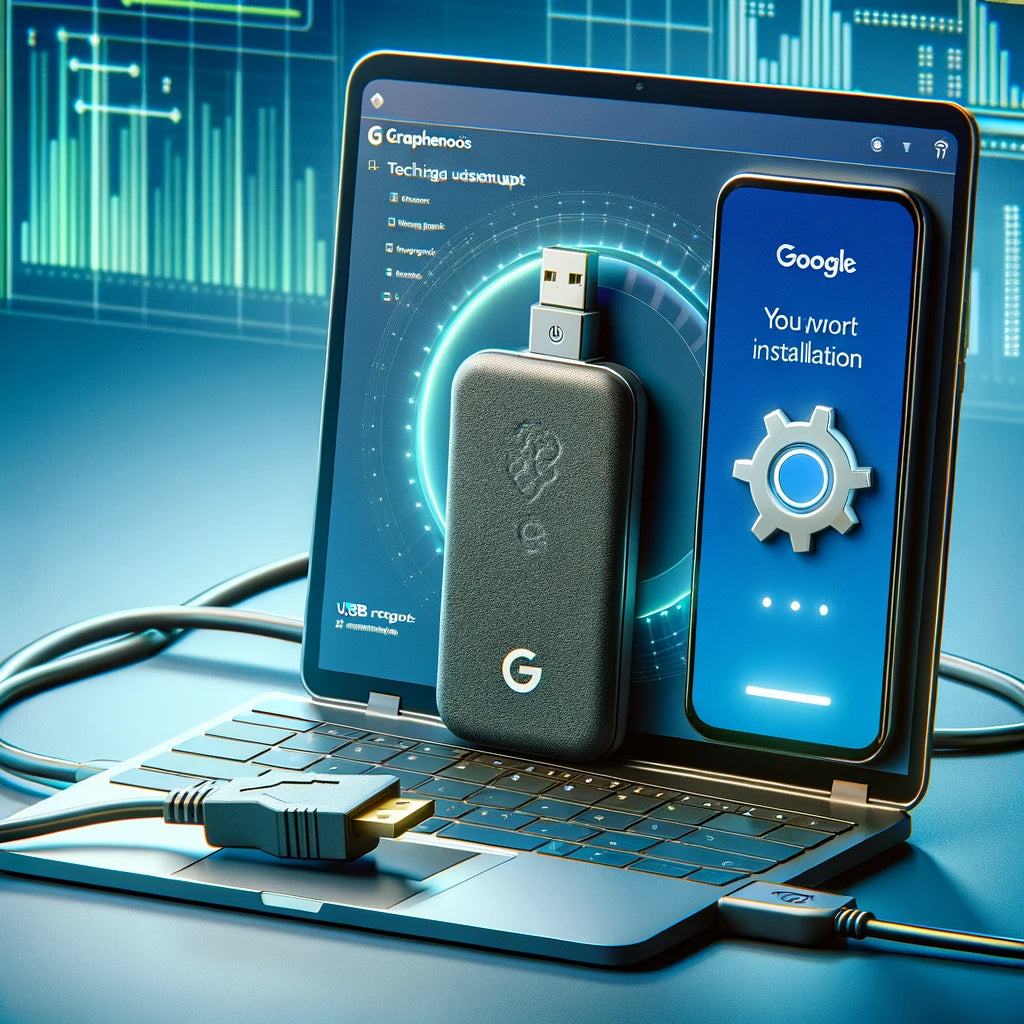If privacy and keeping your Android safe are key, look into GrapheneOS. It's a custom ROM with strong privacy and security features. This guide will help you install GrapheneOS on a compatible device. By doing so, you make sure your phone is safe from unwanted entry.
Key Takeaways:
- GrapheneOS is a privacy-focused custom ROM for Android smartphones.
- It offers enhanced security features and a robust privacy-centered environment.
- Before installation, back up your personal files as the process involves data deletion.
- Ensure your device meets the minimum requirements of 2GB RAM and 32GB storage space.
- Follow the official installation guide and use the recommended installation methods to avoid outdated information.

GrapheneOS has two main ways to install: a WebUSB tool for most people, and a command-line option for tech experts. Using these official methods is smart. It avoids old guides with wrong info.
If you hit a snag, the GrapheneOS chat can help. The community might just offer the advice you need to push past your hurdle.
Ensure your phone fits GrapheneOS's requirements before installing. It needs Google Pixel models from 5a up, with more support for later models. Your phone must have 2GB RAM and 32GB storage at the least.
The installer works on Windows 10 and 11, newer macOS versions, and major Linux systems. It is also good on browsers like Chrome, Edge, Brave, and more. This makes it easy for many people to use.
During setup, you'll lose all your phone's data. So, back up what you need. Once GrapheneOS is in, locking your phone's bootloader again makes it safer. It improves your phone's checks and stops changes you didn't authorize.
GrapheneOS doesn't include Google's main apps. But, you can add Google Play Services if you really have to. Also, adding a VPN is smart for more privacy and security on Android.
Why Choose GrapheneOS for Mobile Security?
GrapheneOS is a standout in mobile security, known for its focus on privacy. It's made for Google Pixel phones. This system boosts your device's security and privacy. It hands you full control of your Android world while keeping threats away.

Enhancing Privacy through Advanced Features
GrapheneOS makes privacy a top priority. It has features not found in regular Android setups. One of them is storage scopes. It lets apps only touch their own files. This keeps your stuff safe from prying apps.
It also uses contact scopes. This feature lets you only show certain contacts to apps. It's another way GrapheneOS works to keep your private info, well, private.
Emphasizing Control, Privacy, and Security
With GrapheneOS, you decide what your apps can see. You can cut back on the info they get. This step helps keep your data safe and stops sneakier access.
Officially Supported Google Pixel Devices
GrapheneOS is a friend to many Google Pixel phones. It works with:
- Pixel 8 and Pixel 8 Pro
- Pixel Fold
- Pixel Tablet
- Pixel 7a, 7, and 7 Pro
- Pixel 6a, 6, and 6 Pro
- Pixel 5a
Choosing GrapheneOS for these devices ramps up your security and privacy. It makes sure your data is well guarded.
Comprehensive Security Features
GrapheneOS comes packed with security. It's ready for all types of attacks. It has:
- Defense against zero-day vulnerabilities
- Network and sensors permission toggles
- Per-connection MAC randomization
- Private screenshot functionality
- LTE-only mode
All of these features work to keep your device safe.
Focus on Sandboxing and App Security
GrapheneOS is big on sandboxing. It keeps the OS, apps, and processes separate. This stops many common attacks. It gives a strong shield against bad bugs.
Enhanced Privacy and Security Apps
GrapheneOS also made some apps just for you. These include:
- Vanadium WebViewer
- Secure Camera
- Secure PDF Viewer
- Auditor
These apps make browsing and sharing files safer. They're all about keeping your secrets where they belong.
Nonprofit Organization Focused on Privacy and Security
Being a nonprofit lets GrapheneOS focus on you. The free of profit goal means more attention to your security. It promises a system that grows and protects more over time.
Avoiding Traditional Google Apps and Services
GrapheneOS skips the usual Google stuff for your safety. This choice means less data collection on you. It's perfect for those who want their phone to respect their privacy.
Enhanced Privacy with VPN Support
GrapheneOS can link up with IKEv2/IPSec VPNs. This means better privacy online. A VPN hides your steps, keeping you safer while you move around the net.
Custom ROM Installation Considerations
It's a bit of work to get GrapheneOS on your phone. You'll need to know about unlocking bootloaders and adding ROMs. This decision offers more security, but it isn't for everyone. Be sure to research the process well before diving in.
With GrapheneOS, your mobile security and privacy stand strong. Its features put you in charge of your data. It's a thoughtful pick for those serious about staying safe on their mobile.
Official Requirements for Installing GrapheneOS
Before you start, make sure your device can run GrapheneOS. You'll need a device it supports, enough space, and the right operating system.
1. Compatible Devices
GrapheneOS works on Google Pixel phones and tablets. Check if your device is on the list of supported ones: Pixel 8 Pro, Pixel 8, Pixel Fold, Pixel 7, Pixel 7 Pro, and Pixel Tablet.
2. Storage Space
Your phone needs at least 32GB of free space. This is for the system files of GrapheneOS and updates.
3. Supported Operating Systems
You need a computer with the right operating system to install GrapheneOS. This can be Windows 10, Windows 11, macOS, or various Linux systems. Also, it works with ChromeOS and some versions of Android.
4. Web Install Method
To install via the web, use one of these browsers: Chromium, Vanadium, Google Chrome, Microsoft Edge, or Brave. This method works with ChromeOS and official Pixel systems.
Remember to turn on OEM unlocking for the install process. After that, you should turn it off for security. You can do this in your device's settings.
Table: Official Requirements for Installing GrapheneOS
| Requirement | Details |
|---|---|
| Compatible Devices | Google Pixel devices: Pixel 8 Pro, Pixel 8, Pixel Fold, Pixel 7, Pixel 7 Pro, Pixel Tablet |
| Storage Space | Minimum 32GB of free storage space |
| Supported Operating Systems | Windows 10, Windows 11, macOS, Arch Linux, Debian, Ubuntu, Linux Mint, ChromeOS, supported versions of Android |
| Web Install Method | Browsers: Chromium, Vanadium, Google Chrome, Microsoft Edge, Brave. Compatible with ChromeOS and stock Pixel OS. |
Meet these requirements to confidently install GrapheneOS. It will make your device more secure and private.
Preparing Your Device for Installation
Before installing GrapheneOS, prep your device. This ensures the mix is smooth. Follow these steps carefully:
1. Enable OEM Unlocking
To unlock the bootloader, first, allow OEM unlocking. Here's how:
- Head to your device's settings.
- Tap on "About phone" at the bottom.
- Locate "Build number" and tap it several times. This makes you a developer.
- Back in settings, find and click "Developer options".
- Turn on "OEM unlocking" by sliding its toggle.
2. Install the Required Drivers
Connecting your device to your computer needs the right drivers. This varies by your system:
- For Windows, get the Android Bootloader Interface driver.
- For Debian or Ubuntu, install android-sdk-platform-tools-common.
3. Gather Your Tools
Before kicking off, have these tools ready:
- A USB-C cable for connection.
- A computer with a supported system (like Windows 10, macOS Big Sur, or an approved Linux).
Now, your device is all set for the next step. Join us in the next section for GrapheneOS's web installer guide.

Installing GrapheneOS with the Web Installer
Installing GrapheneOS on your Google Pixel is easy. It uses a WebUSB-based installer. You do this through your web browser, making it smooth and simple.
First, make sure your device is ready for GrapheneOS. It needs 2GB RAM and 32GB storage. Also, update your browser for a good install.
To begin, unlock your device's bootloader. Turn on OEM unlocking in your device's developer settings. This allows installing GrapheneOS.
After unlocking OEM, power off your device. Boot it into the bootloader by pressing the volume down and power buttons together. Connect it to your computer with a USB.
Use a browser like Chrome or Brave. Go to the GrapheneOS WebUSB installer. Follow the steps to download and flash GrapheneOS.
It's vital to follow the install guide from the GrapheneOS team closely. This helps avoid installation issues.
Once GrapheneOS is installed, turn off OEM unlocking for safety. Use the Auditor app to check your installation.
Remember, GrapheneOS doesn't come with Google apps. But you can add Google Play Services if you need them.
By installing GrapheneOS, your phone gets more privacy and security features. It's made for your safety and lets you customize your experience.
Backing up your data is crucial before you install GrapheneOS. Make sure you read the official guide and check the GrapheneOS website for help.
| Supported Operating Systems | Supported Web Browsers |
|---|---|
| Windows 10 and 11 | Chromium |
| macOS Big Sur, Monterey, Ventura, Sonoma | Vanadium |
| Linux distributions | Google Chrome |
| Microsoft Edge | |
| Brave |
Using the web installer is great for anyone who likes things simple. It makes your device safe and focused on privacy.
| Installation Steps |
|---|
| 1. Turn off your device and enter the bootloader interface. |
| 2. Connect your device to your computer using a USB cable. |
| 3. Open your web browser and visit the GrapheneOS WebUSB-based installer web page. |
| 4. Follow the instructions on the page to unlock the bootloader, download factory images, flash GrapheneOS, and relock the bootloader. |
What to Do After Installing GrapheneOS
Congratulations on successfully installing GrapheneOS on your device! You now have a highly secure and private operating system. There are a few steps you can follow to make sure everything is secure and running smoothly.
1. Disable OEM Unlocking
It's a good idea to turn off OEM unlocking for better security. This feature lets you install custom firmware. But, it can make your device less secure. By turning it off, you make sure only trusted firmware can go on your device.
2. Verify Your GrapheneOS Installation
Make sure your GrapheneOS is real and working right. Use the Auditor app made by the GrapheneOS team. This app checks if your operating system has been messed with. It gives you confidence that your device is safe.
3. Install Google Play Services (Optional)
If you need Google apps that rely on Play Services, you can add them. The Apps app in GrapheneOS lets you get Google Play Services. But remember, it may not be as safe as the rest of GrapheneOS because it's not open source.
4. Return to Stock Firmware (if needed)
If GrapheneOS isn't for you and you want to go back to the old system, there's a way. You can remove the GrapheneOS key and use Google's Android flash tool to reinstall the stock system. Just make sure to follow the guide carefully.
By doing these steps, you can boost your device's security and make sure GrapheneOS is in good shape. Enjoy the safety and privacy that GrapheneOS brings!
GrapheneOS: Privacy and Security Features
GrapheneOS stands out for its strong privacy and security. It's a custom ROM that's known for keeping your device safe. By using it, you're better protected from cyber threats that take advantage of unknown weaknesses.
This ROM fights against threats that can harm all users. It does this by getting rid of things that aren't needed and making sure your device is as secure as possible.
One big goal of this project is to stop attackers from taking over your device. It uses smart techniques to keep the most important parts of your device safe from any attack.
By turning off certain features, GrapheneOS lowers the risk of attacks. For example, it stops apps from being debugged easily, which can also prevent malicious access.
It also uses some of the latest ways to fight against common attacks. These new methods make it much harder for attackers to mess with your device through apps or other means.
GrapheneOS lets you control how apps use your storage. Apps can work with files and folders without being able to see, or mess with, what other apps do.
When it comes to your contacts, GrapheneOS has a clever way to keep them safe. It lets apps see your contact info without letting them change anything.
| GrapheneOS Security Features | GrapheneOS Device Support |
|---|---|
| - Attack surface reduction | - Official production support for various Pixel devices including Pixel 8 Pro, Pixel 8, Pixel Fold, Pixel Tablet, Pixel 7a, Pixel 7 Pro, Pixel 7, Pixel 6a, Pixel 6 Pro, Pixel 6, and Pixel 5a |
| - Verified boot and avoidance of trust in persistent state | - Extended support for end-of-life devices like Pixel 5 and Pixel 4a (5G) |
| - Remote, local, and proximity-based attack surface reduction | - Extended support via a legacy branch based on Android 13 for devices like Pixel 4a, Pixel 4 XL, and Pixel 4 |
| - Hardened app runtime and secure application spawning system | - Recommended devices for better security and minimum support guarantee: Pixel 8 Pro, Pixel 8, Pixel Fold |
| - Hardened libc and custom hardened malloc for memory corruption vulnerabilities | - 7-year minimum support guarantee for 8th generation Pixel devices |
| - Storage Scopes feature for granular storage access control | - Pixel 7 and Pixel 7 Pro offer notable performance improvements over the 6th generation Pixels |
| - Contact Scopes as an alternative to Contacts permission | - The future device support depends on substantial community contributions |
Remember, GrapheneOS doesn't include Google's apps at the start. But, you can put them on if you want to. It's still a good idea to use a VPN with GrapheneOS for even more privacy.
Installing GrapheneOS via the Command-Line Method
If you like hands-on tech stuff, GrapheneOS offers a neat way to install using the command line. This method lets you control the install process more. Following the official guide guarantees a smooth and secure setup.
To use the command-line method, you need the right tools and operating system. Windows 10 and 11, MacOS Monterey, and certain Debian, Ubuntu, and Linux Mint versions are supported. Make sure you use one of these.
Here are the steps to install GrapheneOS using the command-line:
- Make sure your computer fits the system needs:
- You should have at least 2GB of free memory.
- Also, ensure there's 8GB of free storage space.
- Check that you have fastboot version 34.0.5 or newer installed. This is key for a good install.
- Get the platform-tools package from the GrapheneOS site. Then, use the SHA256 checksum (62fc977c1b7622ef8dbd6fe1312987d9b139aa8a0b06e88573c1b60129399d49) to check if the download is correct.
- Next, follow the setup steps in the official guide for your OS.
- After setting up the platform tools, confirm that fastboot is updated to 35.0.0-11411520 or a newer version:
After setup, check that fastboot is at least version 35.0.0-11411520.
- On Arch Linux, install android-udev to use USB devices without root.
- For Windows, make sure the Android bootloader interface driver is installed. It appears as an optional update in Windows Update. This is needed for the fastboot connection to work.
- Connect your phone to your computer with a USB cable. On the phone, enable OEM unlocking in the settings.
- Turn off the phone and start it while pressing the volume down button. This puts it in bootloader mode.
- Now, follow the steps in the guide to install GrapheneOS on your phone.
- Once the install is done, it's wise to lock the bootloader. This helps with better security measures.
The installation will erase everything from your device. Backup your important data before starting. The command-line method is great for those who like control and customization options.
Always check the guide for your OS and device. If you face problems, the GrapheneOS chat channel is there to help.
Troubleshooting and Support for GrapheneOS Installation
If you run into problems installing GrapheneOS, don't worry. There's help ready for you. The best place to get help is the official GrapheneOS chat. Here, you can meet others who are quick to help and give tips.
But, before you ask for help, try to install it using the guide. This guide has steps for each part of the setup. It's made to work on different computers and phones.
Still stuck? Need to ask something about GrapheneOS? Just hop into the chat and ask around. People who know a lot can tell you how to fix things. They've likely faced the same problems and found solutions.
If you need more help, the chat might send you somewhere else to get it. Or, they might help you directly to fix your problem. The aim is to get everyone smoothly using GrapheneOS, with support from the community's skilled members.
Tips for Enhancing Device Security with GrapheneOS
After adding GrapheneOS, your device's security and privacy get a big boost. To make it even safer, try these tips:
1. Turn off OEM Unlocking (unless you are a developer)
Disabling OEM unlocking is wise. It keeps your bootloader locked, making your device safer from threats. Only keep this on if you're developing apps.
2. Verify the Installation with the Auditor App
The Auditor app is from GrapheneOS. It checks if your OS is original and not tampered. This ensures your device runs securely.
3. Consider Using a VPN
A VPN makes your online activities more secure. It scrambles your data, keeping it safe from peeking hackers. It also hides your IP address.
Choose a VPN service that respects privacy and keeps no logs. Make sure it works with GrapheneOS, and meets your needs.
Note: Remember that a VPN is just one tool in your security toolbox. It should be used in conjunction with other security measures, such as strong passwords and regular software updates.
By using these tips and GrapheneOS's features, your mobile experience will be safer and private.
Conclusion
GrapheneOS offers extra security and privacy for Google Pixel phones. I've used it on my Google Pixel 6a for more than a year. I believe its security and privacy features are top-notch.
GrapheneOS looks like standard Android but may have some graphical issues. Yet, it's big on security and privacy. It gets better with frequent updates. These updates make my phone restart faster, only taking about 5 minutes.
The battery life on GrapheneOS is amazing. It can last for days even with heavy use. I like using Google's apps on GrapheneOS because they work really smoothly. This balances privacy and convenience well.
Making choices that protect our privacy is important. We should think about how we use social media and apps. GrapheneOS helps by offering better security, great battery life, and working well with apps. It does a better job at protecting our privacy than big companies like Google or Apple.
FAQ
What is GrapheneOS?
GrapheneOS is a special system for Google Pixel phones. It makes your device safer and more private. It does this with unique features that are not in normal Android.
What are the officially supported installation methods for GrapheneOS?
GrapheneOS can be installed in two ways. There's one for most users which is the WebUSB installer. Then there's one for tech-savvy users, the command-line guide.
How can I ensure that I have the correct information for installing GrapheneOS?
For the latest and right info on installing GrapheneOS, stick to the official methods. If you run into problems, go to the official GrapheneOS chat for help.
What are the requirements for installing GrapheneOS?
To install GrapheneOS, your device must fit certain criteria. This includes having the right Android device, at least 2GB RAM, 32GB storage, a USB-C cable, and a computer running an approved OS.
How do I prepare my device for GrapheneOS installation?
First, unlock OEM in your phone's settings by tapping on "Build Number". You also need the correct drivers on your computer, like Android's bootloader driver for Windows or android-sdk-platform-tools-common for Debian and Ubuntu.
How do I install GrapheneOS using the web installer?
To use the web installer, first turn off your device. Connect it to your computer via USB while in bootloader mode. Then, open a web browser to go to the GrapheneOS WebUSB installer page to continue with the process.
What should I do after installing GrapheneOS?
After you've installed GrapheneOS, think about turning off OEM unlocking. Use the Auditor app to check your install and add Google Play Services if you need them. For extra security, consider using a VPN.
What features does GrapheneOS offer for privacy and security?
GrapheneOS is all about keeping your data and device safe. Even without Google apps, it offers a very secure Android environment. It has many special features for privacy and security, making your device even more secure.
How can I install GrapheneOS via the command-line method?
For advanced users, GrapheneOS has a guide for installing through the command line. Make sure you have the right tools and an approved operating system first. Then, follow the detailed steps in the guide.
Where can I find troubleshooting and support for GrapheneOS installation?
If problems come up, the best place for help is the official GrapheneOS chat. The community is there to help. But try to solve your problem by following the guide first.
What are some tips for enhancing device security with GrapheneOS?
For better safety, after installing GrapheneOS, turn off OEM unlocking unless you really need it. Verify your installation with the Auditor app. Lastly, think about using a VPN for more privacy and security.








